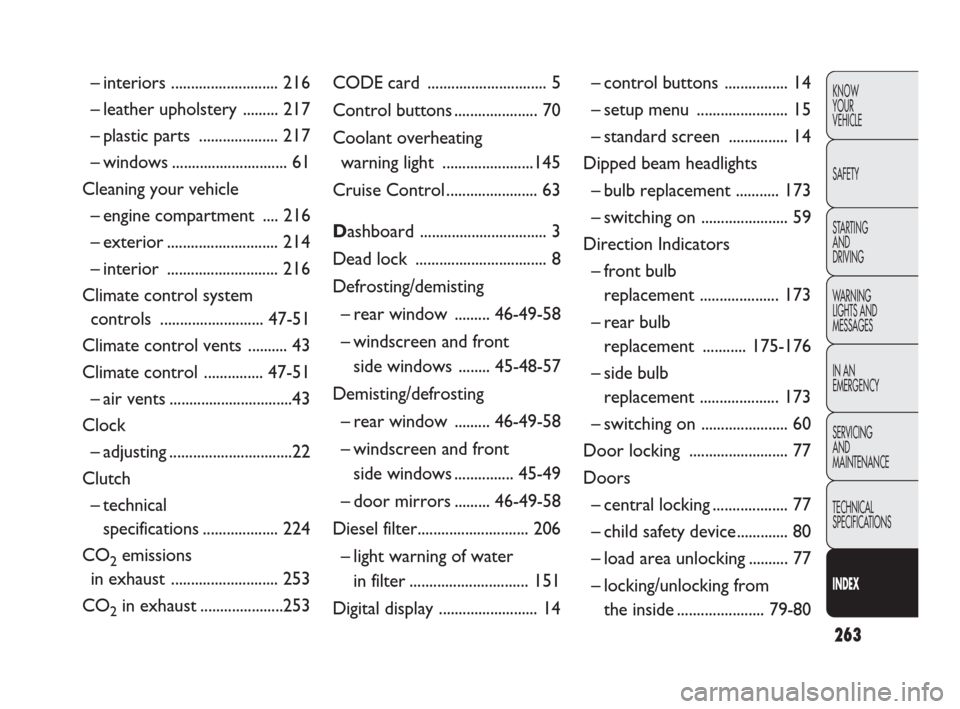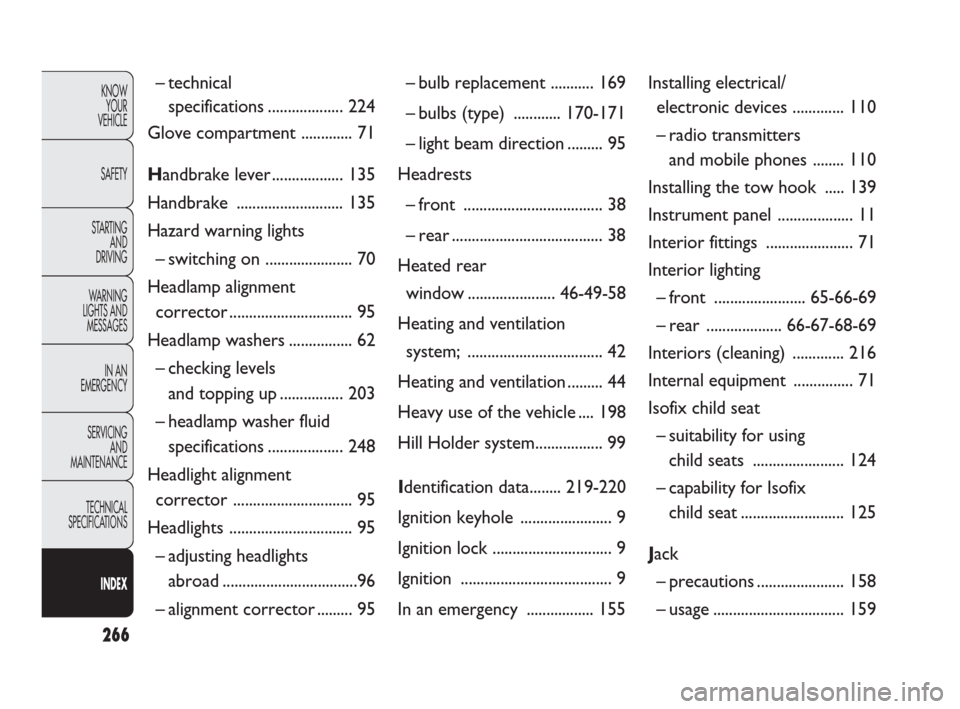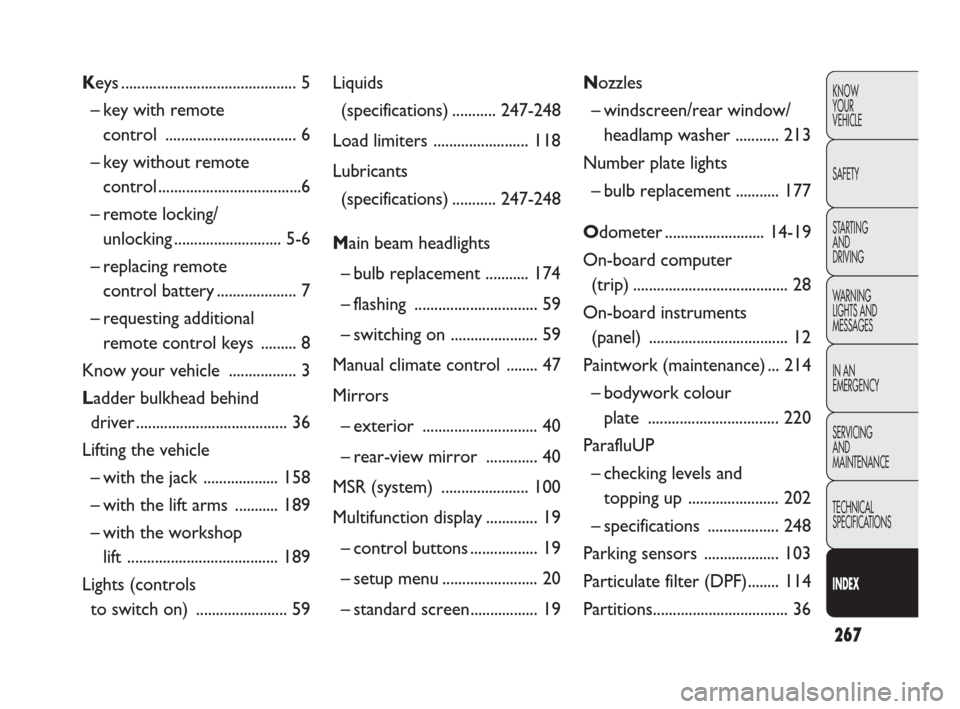headlights FIAT DOBLO 2009 2.G User Guide
[x] Cancel search | Manufacturer: FIAT, Model Year: 2009, Model line: DOBLO, Model: FIAT DOBLO 2009 2.GPages: 274, PDF Size: 6.6 MB
Page 217 of 274

216
KNOW
YOUR
VEHICLE
SAFETY
STARTING
AND
DRIVING
WARNING
LIGHTS AND
MESSAGES
IN AN
EMERGENCY
SERVICING
AND
MAINTENANCE
TECHNICAL
SPECIFICATIONS
INDEXINTERIORS
Check regularly that water is not trapped under the mats
(from dripping off shoes, umbrellas, etc.) which could cause
the metal to rust. Windows
Use specific detergents to clean the windows. Also use
clean cloths to avoid scratching the glass or altering the
transparency.
IMPORTANT Wipe the rear window gently with a cloth
in the direction of the filaments to avoid damaging the
heating device.
Engine compartment
At the end of each winter, thoroughly wash the engine
compartment, taking care to avoid spraying the water jet
directly onto the electronic control units and the relay/fuse
control unit on the left side of the engine compartment
(as you look from behind the wheel). Have this operation
performed at a specialist garage.
IMPORTANT The washing should take place with the en-
gine cold and the ignition key in the STOP position. After
the wash, make sure that the various protective devices
(e.g. rubber caps and guards) have not been removed or
damaged.
Front headlights
IMPORTANT Never use aromatic substances (e.g. petrol)
or ketenes (e.g. acetone) for cleaning the plastic lenses of
the front headlights.
Never use flammable products, such as pe-
troleum ether or modified petrol, to clean
the inside of the vehicle. The electrostatic charges
which are generated by rubbing during cleaning
may cause a fire.
WARNING
Do not keep aerosol cans in the vehicle:
these could explode. Aerosol cans must
not be exposed to temperatures of more than
50 °C. When the vehicle is exposed to sunlight,
the temperature inside can greatly exceed this
value.
WARNING
Page 251 of 274

250
KNOW
YOUR
VEHICLE
SAFETY
STARTING
AND
DRIVING
WARNING
LIGHTS AND
MESSAGES
IN AN
EMERGENCY
SERVICING
AND
MAINTENANCE
TECHNICAL
SPECIFICATIONS
INDEX
9. Air conditioning leads to higher fuel consumption (on
average up to +30%). If the temperature outside is not
too extreme, try and use the air vents.
Driving style
1. After starting the engineyou should drive away im-
mediately and slowly, avoiding high revs. Do not warm
up the engine at low or high revs when the vehicle is
stationary; this causes the engine to warm up more
slowly, thereby increasing fuel consumption, emissions
and mechanical component wear.
2. Avoid pointless actions such as revving up when at
traffic lights or before stopping the engine. The latter
action, like double-declutching, is unnecessary and caus-
es increased fuel consumption and pollution.
3.Gear selection: select a high gear as soon as possible
(taking into account normal engine operation and traf-
fic conditions) without pushing the engine to high revs
during the intermediate gears. Using low gears at high
revs to get excellent acceleration increases fuel con-
sumption, harmful emissions and engine wear. PRACTICAL ADVICE FOR REDUCING FUEL
CONSUMPTION AND HARMFUL EMISSIONS
Vehicle condition
1. Have checks and servicingcarried out in accordance
with the “Scheduled servicing plan”.
2. Check tyre pressure regularly, at least once every four
weeks. Excessively low pressures will increase con-
sumption because rolling resistance will be higher. In
these conditions, the tyre will wear and performance
will decay faster.
3. Use snow tyresonly when the weather conditions
make them absolutely necessary. They increase con-
sumption and noise.
4. Do not travel with a heavy load: the weight of the
vehicle (especially when driving in town) and its trim
greatly affect fuel consumption and stability.
5. Remove roof racks or ski racksafter use. These ac-
cessories reduce the vehicle’s aerodynamic penetra-
tion and have a negative effect on fuel consumption.
6. It is better to use a trailer to transport particularly bulky
objects.
7. Use the vehicle’s air vents if possible: travelling with the
windows open impairs aerodynamics.
8. Use electrical devices only for the amount of time
needed. The heated rear window, auxiliary headlights,
windscreen wipers and fan heater use up a consider-
able amount of current, causing increased fuel con-
sumption (up to +25% in the urban cycle).
Page 264 of 274

263
KNOW
YOUR
VEHICLE
SAFETY
STARTING
AND
DRIVING
WARNING
LIGHTS AND
MESSAGES
IN AN
EMERGENCY
SERVICING
AND
MAINTENANCE
TECHNICAL
SPECIFICATIONS
INDEX
CODE card .............................. 5
Control buttons..................... 70
Coolant overheating
warning light .......................145
Cruise Control....................... 63
Dashboard ................................ 3
Dead lock ................................. 8
Defrosting/demisting
– rear window ......... 46-49-58
– windscreen and front
side windows ........ 45-48-57
Demisting/defrosting
– rear window ......... 46-49-58
– windscreen and front
side windows............... 45-49
– door mirrors ......... 46-49-58
Diesel filter............................ 206
– light warning of water
in filter.............................. 151
Digital display ......................... 14– control buttons ................ 14
– setup menu ....................... 15
– standard screen ............... 14
Dipped beam headlights
– bulb replacement ........... 173
– switching on ...................... 59
Direction Indicators
– front bulb
replacement .................... 173
– rear bulb
replacement ...........175-176
– side bulb
replacement .................... 173
– switching on ...................... 60
Door locking ......................... 77
Doors
– central locking................... 77
– child safety device............. 80
– load area unlocking .......... 77
– locking/unlocking from
the inside......................79-80 – interiors ........................... 216
– leather upholstery ......... 217
– plastic parts .................... 217
– windows............................. 61
Cleaning your vehicle
– engine compartment .... 216
– exterior............................ 214
– interior ............................ 216
Climate control system
controls ..........................47-51
Climate control vents .......... 43
Climate control ............... 47-51
– air vents ...............................43
Clock
– adjusting ...............................22
Clutch
– technical
specifications................... 224
CO
2emissions
in exhaust ........................... 253
CO
2in exhaust .....................253
Page 267 of 274

266
KNOW
YOUR
VEHICLE
SAFETY
STARTING
AND
DRIVING
WARNING
LIGHTS AND
MESSAGES
IN AN
EMERGENCY
SERVICING
AND
MAINTENANCE
TECHNICAL
SPECIFICATIONS
INDEX
– technical
specifications................... 224
Glove compartment ............. 71
Handbrake lever.................. 135
Handbrake ........................... 135
Hazard warning lights
– switching on ...................... 70
Headlamp alignment
corrector............................... 95
Headlamp washers................ 62
– checking levels
and topping up................ 203
– headlamp washer fluid
specifications................... 248
Headlight alignment
corrector .............................. 95
Headlights ............................... 95
– adjusting headlights
abroad ..................................96
– alignment corrector ......... 95– bulb replacement ........... 169
– bulbs (type) ............ 170-171
– light beam direction ......... 95
Headrests
– front ................................... 38
– rear ...................................... 38
Heated rear
window......................46-49-58
Heating and ventilation
system; .................................. 42
Heating and ventilation ......... 44
Heavy use of the vehicle .... 198
Hill Holder system................. 99
Identification data........ 219-220
Ignition keyhole ....................... 9
Ignition lock .............................. 9
Ignition ...................................... 9
In an emergency ................. 155Installing electrical/
electronic devices ............. 110
– radio transmitters
and mobile phones ........ 110
Installing the tow hook ..... 139
Instrument panel ................... 11
Interior fittings ...................... 71
Interior lighting
– front .......................65-66-69
– rear ...................66-67-68-69
Interiors (cleaning) ............. 216
Internal equipment ............... 71
Isofix child seat
– suitability for using
child seats ....................... 124
– capability for Isofix
child seat.......................... 125
Jack
– precautions...................... 158
– usage ................................. 159
Page 268 of 274

267
KNOW
YOUR
VEHICLE
SAFETY
STARTING
AND
DRIVING
WARNING
LIGHTS AND
MESSAGES
IN AN
EMERGENCY
SERVICING
AND
MAINTENANCE
TECHNICAL
SPECIFICATIONS
INDEX
Keys ............................................ 5
– key with remote
control ................................. 6
– key without remote
control ....................................6
– remote locking/
unlocking........................... 5-6
– replacing remote
control battery.................... 7
– requesting additional
remote control keys ......... 8
Know your vehicle ................. 3
Ladder bulkhead behind
driver...................................... 36
Lifting the vehicle
– with the jack ................... 158
– with the lift arms ........... 189
– with the workshop
lift ...................................... 189
Lights (controls
to switch on) ....................... 59Liquids
(specifications)...........247-248
Load limiters ........................ 118
Lubricants
(specifications)...........247-248
Main beam headlights
– bulb replacement ........... 174
– flashing ............................... 59
– switching on ...................... 59
Manual climate control ........ 47
Mirrors
– exterior ............................. 40
– rear-view mirror ............. 40
MSR (system) ...................... 100
Multifunction display............. 19
– control buttons................. 19
– setup menu ........................ 20
– standard screen................. 19Nozzles
– windscreen/rear window/
headlamp washer ........... 213
Number plate lights
– bulb replacement ........... 177
Odometer.........................14-19
On-board computer
(trip)....................................... 28
On-board instruments
(panel) ................................... 12
Paintwork (maintenance) ... 214
– bodywork colour
plate ................................. 220
ParafluUP
– checking levels and
topping up ....................... 202
– specifications .................. 248
Parking sensors ................... 103
Particulate filter (DPF)........ 114
Partitions.................................. 36